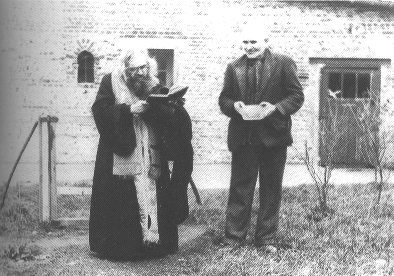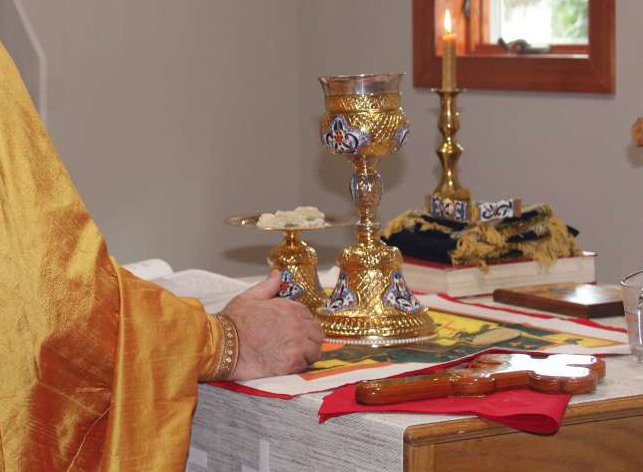When I came to San Francisco to be close to the saintly Archbishop John Maximovitch, I heard a lot of fascinating accounts of his ascetic life. Frequently I visited St. Tikhon’s Orphanage, founded by this Saint, and run then by his long-time assistant, Mrs. Maria Alexandrovna Shakhmatova (+1967). Archbishop John was a very busy man, and I did not dare to be often in his presence…
The orphanage was no longer a place where children were sheltered….Within its walls was Archbishop John’s tiny office, which was so small that even a bed would not fit, where he both lived and had his prayer-room and office…I would visit him there, and have long constructive talks that shaped my life.

This particular day I noticed a white pigeon with a reddish pattern in its feathers, making pigeon noises outside the window on a specially built ledge. It was pacing back and forth, obviously not intending to fly away, but, as I assumed, waiting to be fed. As it seemed no stranger to her, I paid little attention then.
On that particular feast day of the Baptism of the Lord, I chanced to be in St. Tikhon’s for the Blessing of Water. The service was performed in the little courtyard right under the kitchen window, which had a separate gate from the street through which I had entered. To my great surprise, as St. John was blessing the water, a dove flew right out into the courtyard. It flapped its wings and actually soared over the basin of holy water, while all of us vigorously sang: “When Thou, O Lord, west baptized in the Jordan, the worship of the Trinity was made manifest. For the voice of the Father bore witness unto Thee, calling Thee the beloved Son, and the Spirit in the form of a dove confirmed His word as sure and steadfast …” I was amazed, as I had never seen such a service with a live dove hovering over this holiness.
The sight was unforgettable. St. John stood there with lifted hands, holding a huge golden Cross high above his mitered head, and the bird flew high about the building next door, and then with a swift graceful glide descended upon the Saint and sat on his shoulder. Then, loudly flapping its wings, it flew way up into the air, only to descend again, to the utter joy of all there, and it did this several times. St. John, apparently oblivious to the bird’s spectacular maneuvers, continued deep in prayer. It seemed so natural, as if it were all a standard part of the holy ceremony. A similar event occurred in the life of St. Basil the Great, when a dove was seen by St. Ephraim the Syrian to be whispering holy words into St. Basil’s ear.
After the service I was invited to drink a lot of the water inside St. Tikhon’s Orphanage, and to partake of tasty treats. Archbishop John was there, and the bird was outside the window on his ledge, apparently feeding. There I learned the following touching story of Archbishop John’s “heavenly bird.”
Once Archbishop John came home to discover that a pigeon was hurt, his wing was damaged, and was sitting outside the window. He opened the window and let it in. The bird could barely flutter, and Archbishop John bound its wing and fed it. That was enough to make it feel adopted. The bird stayed around, especially when the Saint would arrive and would feed it. Actually it remained a mystery how both of them conversed. But one thing we knew: the pigeon reacted to the words of St. John as if it understood what he said. I was told that both of them would sit facing each other, the man softly speaking and the bird making its pigeon sounds in agreement and peacefully walking to and fro, as if memorizing what it was taught. This company Archbishop John kept for a long time, until his death. The pigeon lived on that window ledge and would often fly around in the kitchen and the main visiting room, and in the little corner office of Mrs. Shakmatova in the northwestern corner of the house. I saw the bird fly around, and wondered why they had no cage for it, as for a canary. But I was told, “It is Archbishop John’s friend and companion.” It was a friendly bird, often eating from his hands.
Once I came and saw Archbishop John sitting silently next to the window, his head in his hand, thinking, watching the bird; and the bird was sick. I never learned what was the matter, but there was silent contact between the dove of the Baptism of the Lord and John its “Baptist.” (The altar boys said that, by sprinkling the bird during the blessing of the water, Archbishop John had baptized the pigeon, and that it was a “baptized” bird.) Mrs. Shakmatova later told me that the bird was a sort of messenger of mysteries for Blessed John, but I never pried for an explanation. On the day Archbishop John died, the bird began to pace the window and flutter in agony, as if knowing about its master.
One frequenter of St. Tikhon’s Orphanage wrote:
We all learned to love that little friendly bird, who became a close friend to man. It never flew too far from the house and never chased other birds, as if its little heart sought warmth from people; and it had no greater joy than to fly into the house and sit quietly on some corner of an armchair. Often when Archbishop John would drink coffee in the kitchen, the bird would knock at the window pane begging to be let in and then it would sit on the Saint’s shoulder and watch his hands as he blessed the bird.
When the death knell announced the earthly end of Archbishop John, the bird was frantic. It fluttered in agony, missing the Saint, and its little heart also stopped a few months afterwards, to our deep sorrow.
I remember how someone said firmly that one should not cry over a bird, it is sinful. How harsh this resounded in my ears! Why is it a sin when a quiet sadness touches a heart over the loss of the little ones given to us by the Lord Himself to protect, who also are capable of giving us love. I remember Archbishop John’s words to me when I used to complain that in some cities birds are removed from the streets: ‘Yes, now throughout the whole world, attacks are carried out against all living beings that surround us.
At that time there was a veritable persecution of pigeons in San Francisco, due to the assumption that they carried some disease, and hundreds of them were poisoned or shot. I do not know these details. But I do remember vividly the beautiful white-feathered creature flying about the little bentdown figure of the precious Saint, who not only loved this God-sent bird, but had some mystical contact with it. The bird appeared in his life when he endured the greatest of his earthly trials; it forbade his ascent to the other world, and some other mysteries I was told about. That feathered little creature of God was sent as a consolation to the sorrowing man of God, rendering him greater solace than men could do, who at that time were inflicting upon him his greatest pain. Men who hate men cannot understand how animals could be truly God-sent consolers.
A spiritual daughter of Archbishop John, Olga Skopichenko, recalling this dove, even wrote a lovely poem, in which she hinted that the appearance of the bird, damaged by cruel men, was for our Saint a little window through which he gazed into heaven.
Source: Urban Wildlife Society






